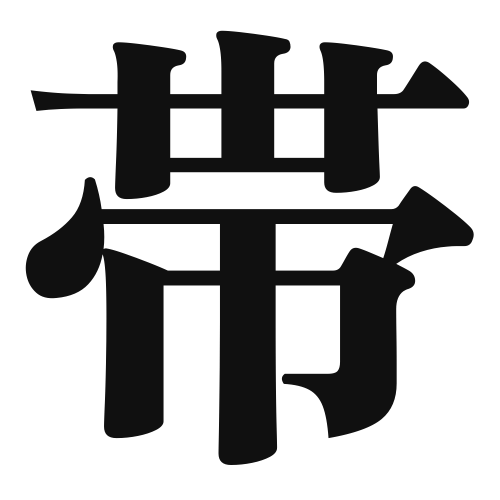1. Overview of Meaning
The kanji “帯” (pronounced “obi” in Japanese) primarily means “belt” or “band.” It refers to a strip of material used to secure clothing or carry items. Additionally, it can denote a range or zone, such as in the context of a “belt” of land or a specific area of influence.
2. Formation and Radical
Formation of the Kanji: The kanji “帯” is a compound character (会意文字) that combines elements to convey its meaning. It consists of the radical “巾” (meaning “cloth”) and the character “タイ” (which relates to the concept of “to carry” or “to bring”).
Radical: The radical of “帯” is “巾,” which is associated with cloth or fabric, emphasizing its connection to items that are worn or used in a binding manner.
3. Examples of Usage
Common Words and Phrases: Some frequently used words that include “帯” are:
- 帯 (おび, obi) – a traditional Japanese sash or belt
- 帯域 (たいき, taiiki) – bandwidth or frequency band
Example Sentences in Daily Conversation:
- 「この着物には美しい帯が付いています。」(This kimono has a beautiful obi.)
- 「彼は新しい帯域を設定しました。」(He set up a new bandwidth.)
4. Synonyms and Antonyms
Similar Kanji: A similar kanji is “紐” (ひも, himo), which means “string” or “cord.” While both can refer to items used for binding, “帯” specifically refers to a wider, more structured item like a belt, whereas “紐” refers to a thinner, more flexible string.
Opposite Kanji: An antonym could be “解く” (とく, toku), which means “to untie” or “to loosen.” This contrasts with “帯,” which implies binding or securing.
5. Cultural and Historical Background
Connection to Japanese Culture: The “obi” is an essential part of traditional Japanese attire, especially in kimono fashion. It symbolizes not only functionality but also aesthetic beauty and cultural heritage.
Proverbs and Idioms: One common expression is “帯に短し襷に長し” (おびにみじかしたすきにながし), which translates to “too short for a belt, too long for a sash,” indicating something that is not suitable for its intended purpose.
